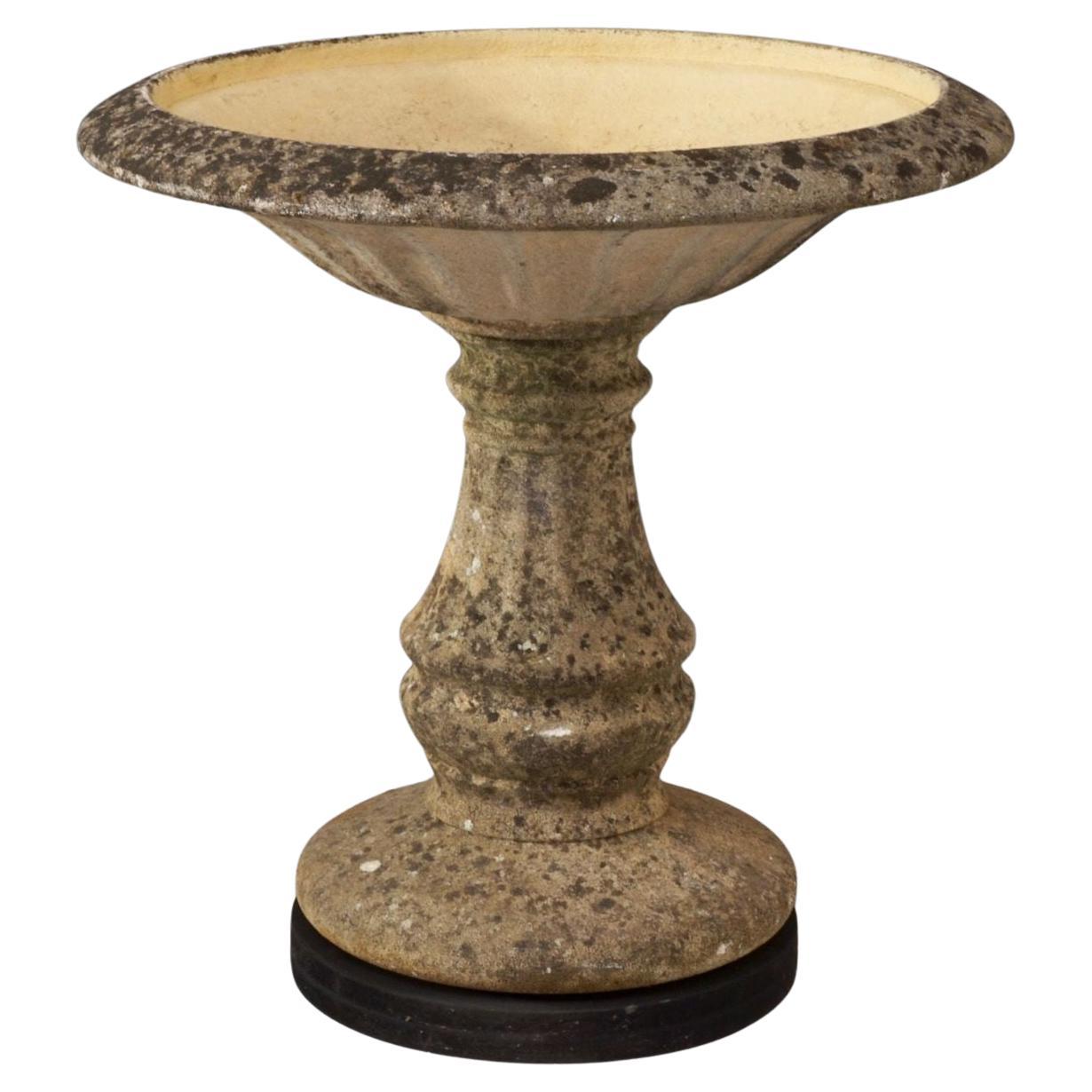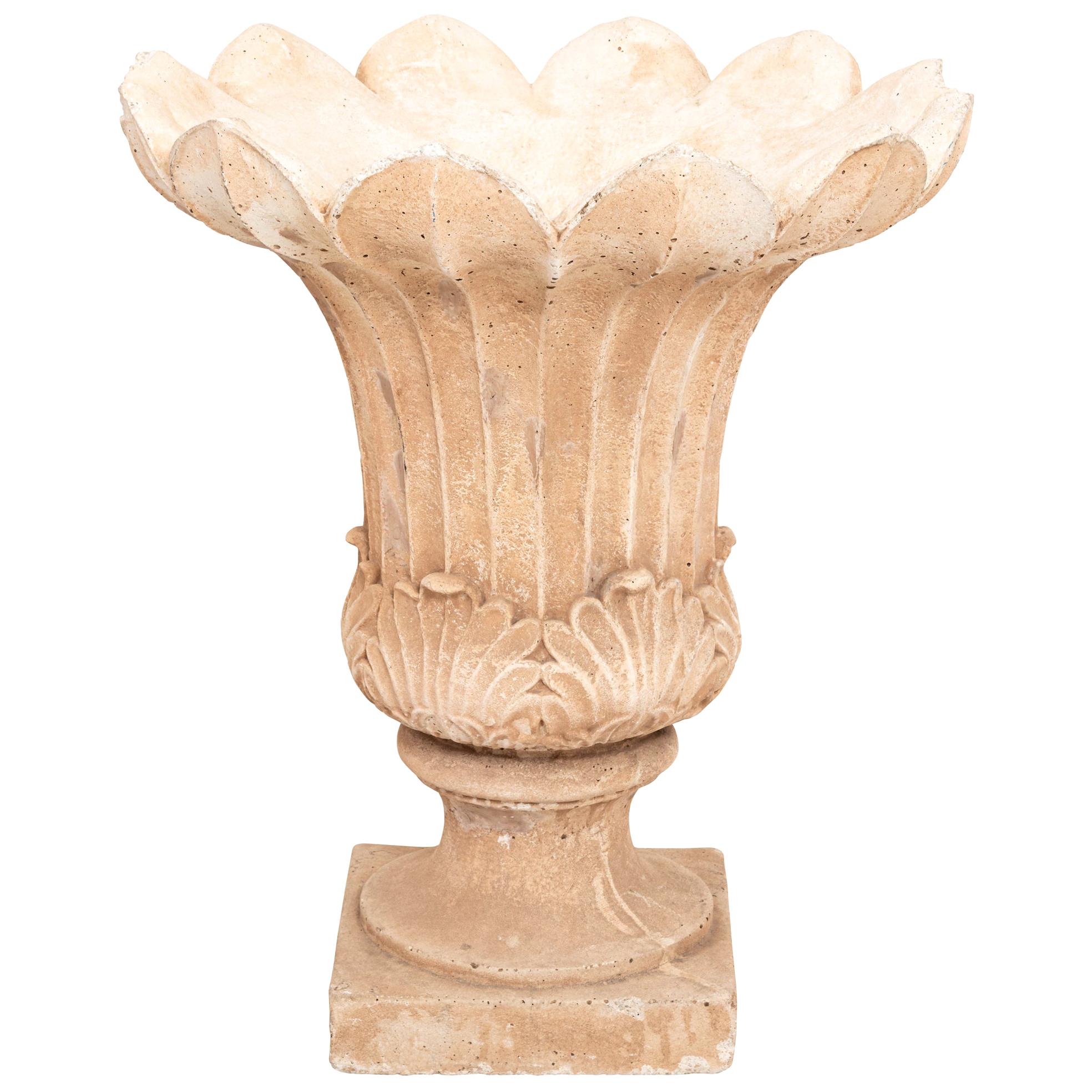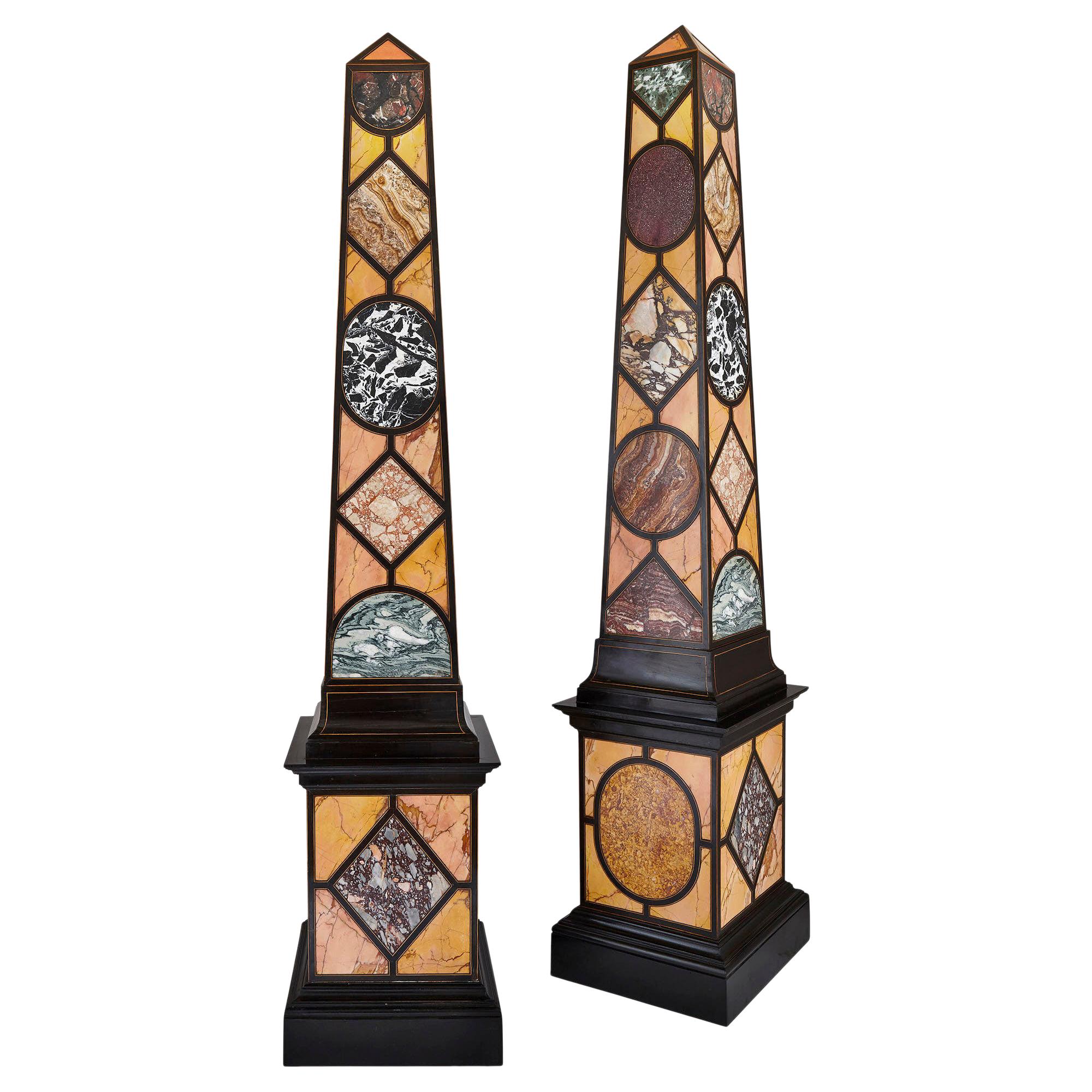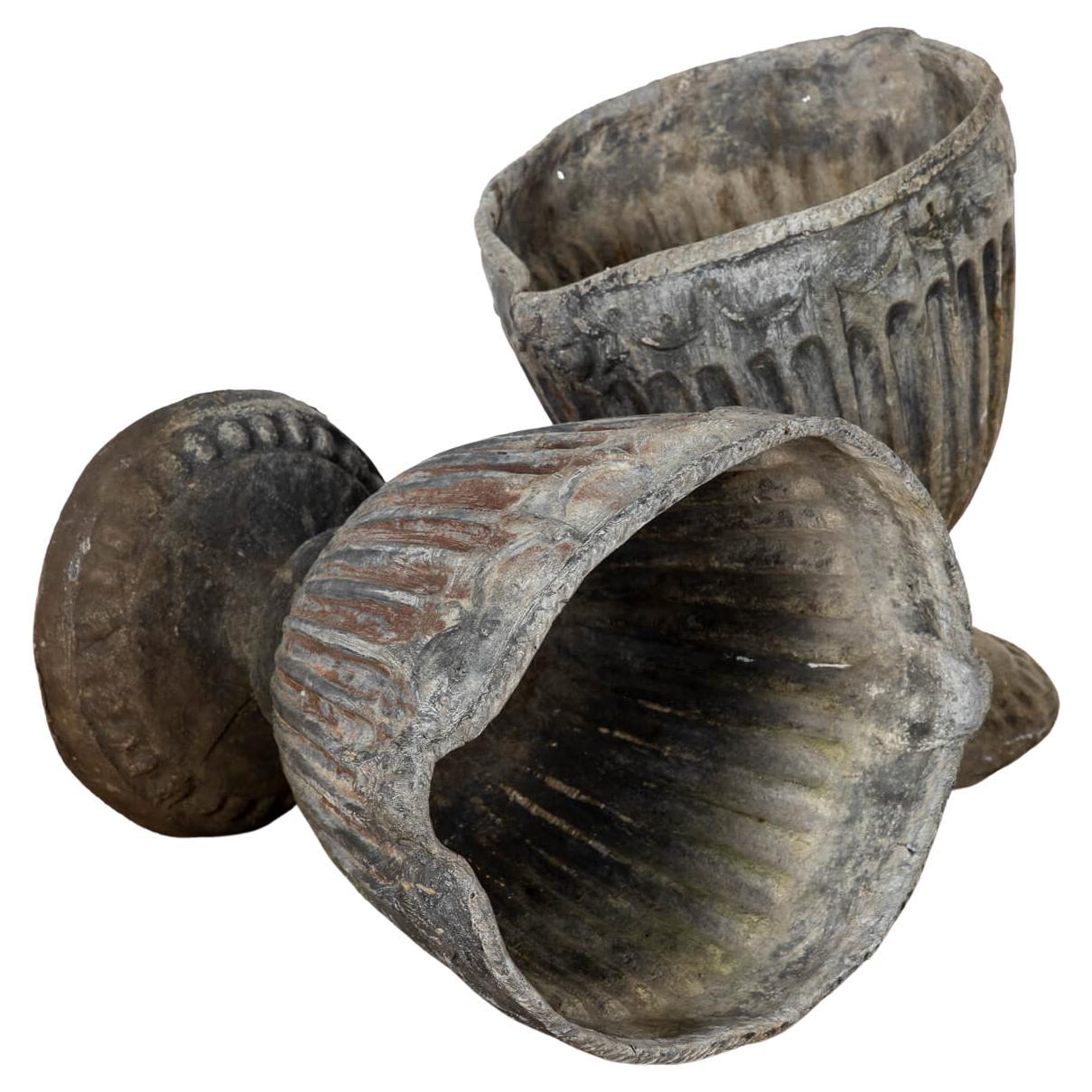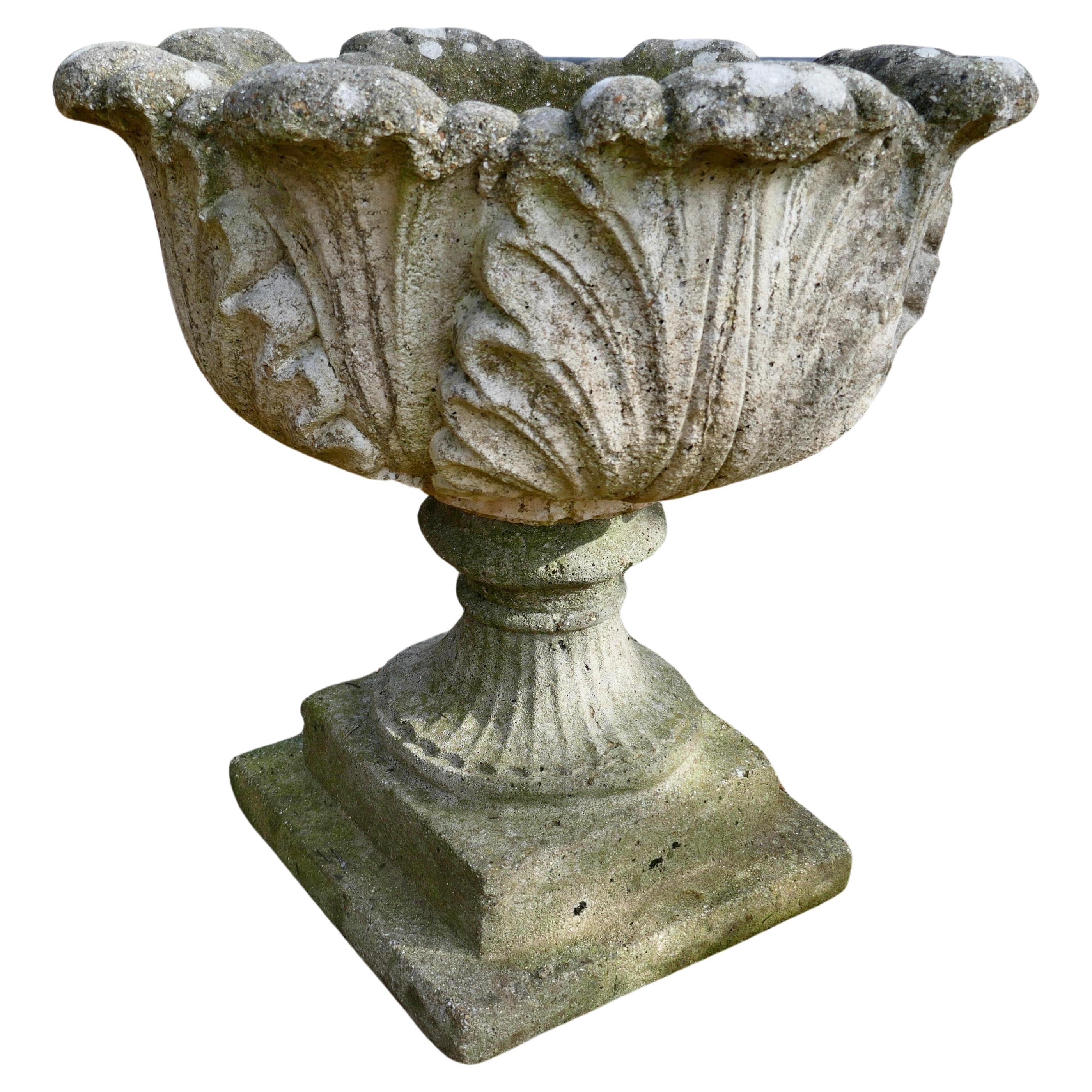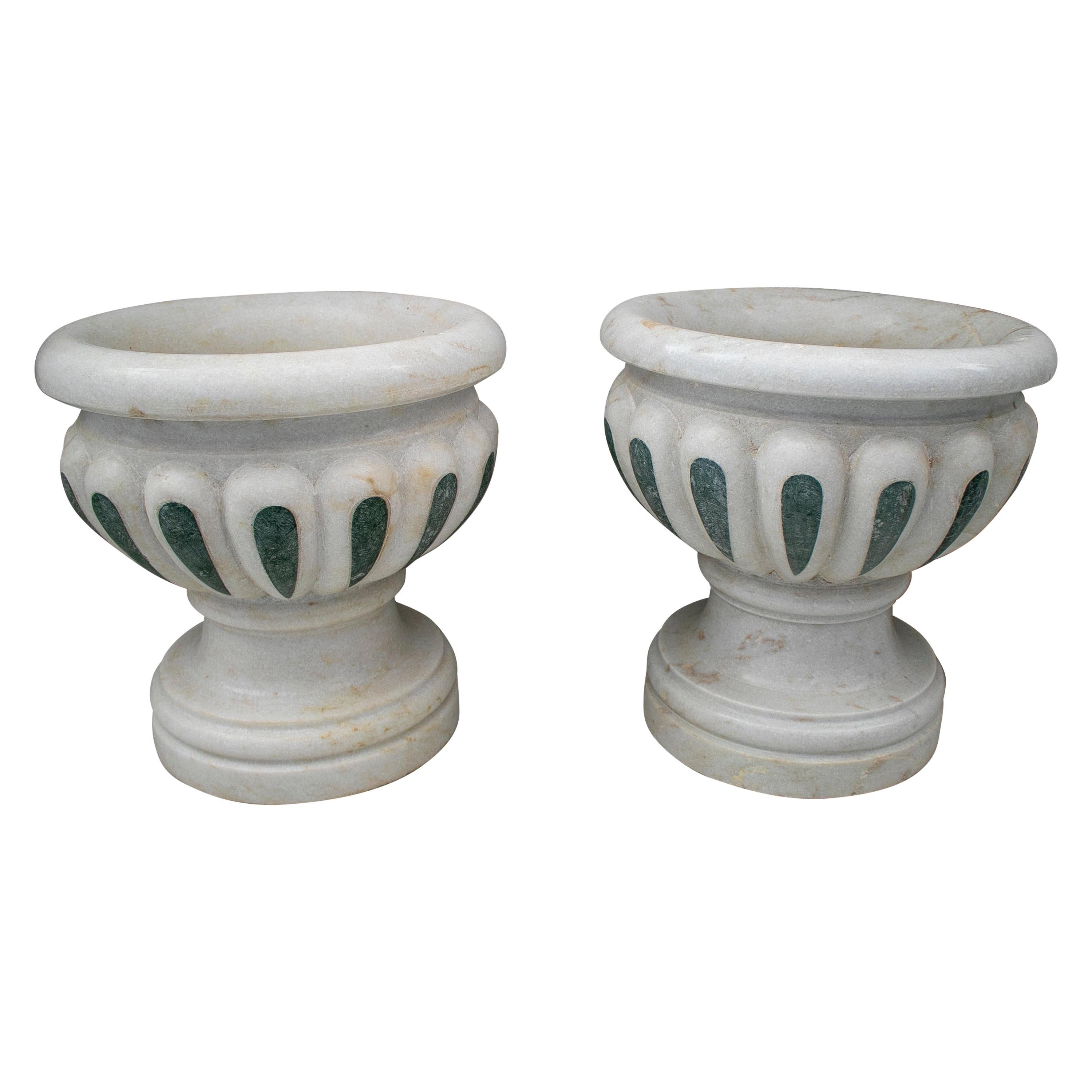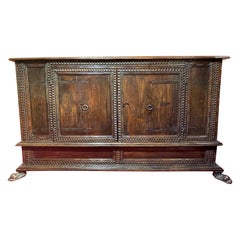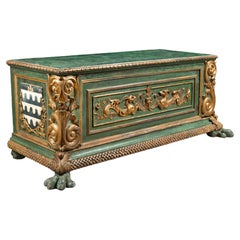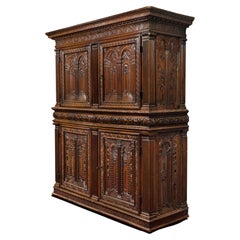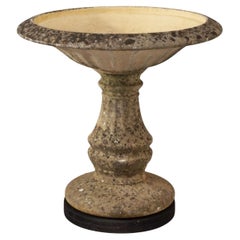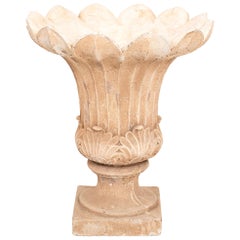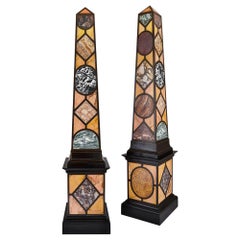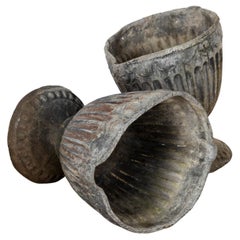Items Similar to Important Italian Renaissance Revival Marble Garden Planter
Want more images or videos?
Request additional images or videos from the seller
1 of 12
Important Italian Renaissance Revival Marble Garden Planter
About the Item
IMPORTANT ITALIAN RENAISSANCE REVIVAL MARBLE GARDEN PLANTER
ORIGIN: NORTHERN ITALY
PERIOD: 19th CENTURY
Height: 52 cm
Length: 130 cm
Depth: 53 cm
Verona marble
Taking the form of an antique sarcophagus, this architectural element is adorned with powerful and animated sculpted motifs. Supported by a base of powerful gadroons, it features a particularly expressive mask of a satyr with goat's horns on its main face. It is flanked by two symmetrical scrolls of acanthus leaves. These scrolls are inhabited by eagles with wide open beaks.
The sides each bear a decorative coat of arms. On the first is a griffin, while the second shows a small character with pointed ears, carrying a flowery basket on his head.
On the rear side a coat of arms (1. Lion rampant ; 2. Tree torn out) framed by stems and leaves, the end of which forms a winged lion with a leafy body.
The upper edge is underlined by a frieze of heart-shaped grapes.
- Dimensions:Height: 20.48 in (52 cm)Width: 51.19 in (130 cm)Depth: 20.87 in (53 cm)
- Materials and Techniques:
- Period:
- Date of Manufacture:19th Century
- Condition:Wear consistent with age and use. Minor losses. Minor structural damages. Minor fading.
- Seller Location:Saint-Ouen, FR
- Reference Number:1stDibs: LU3115336025362
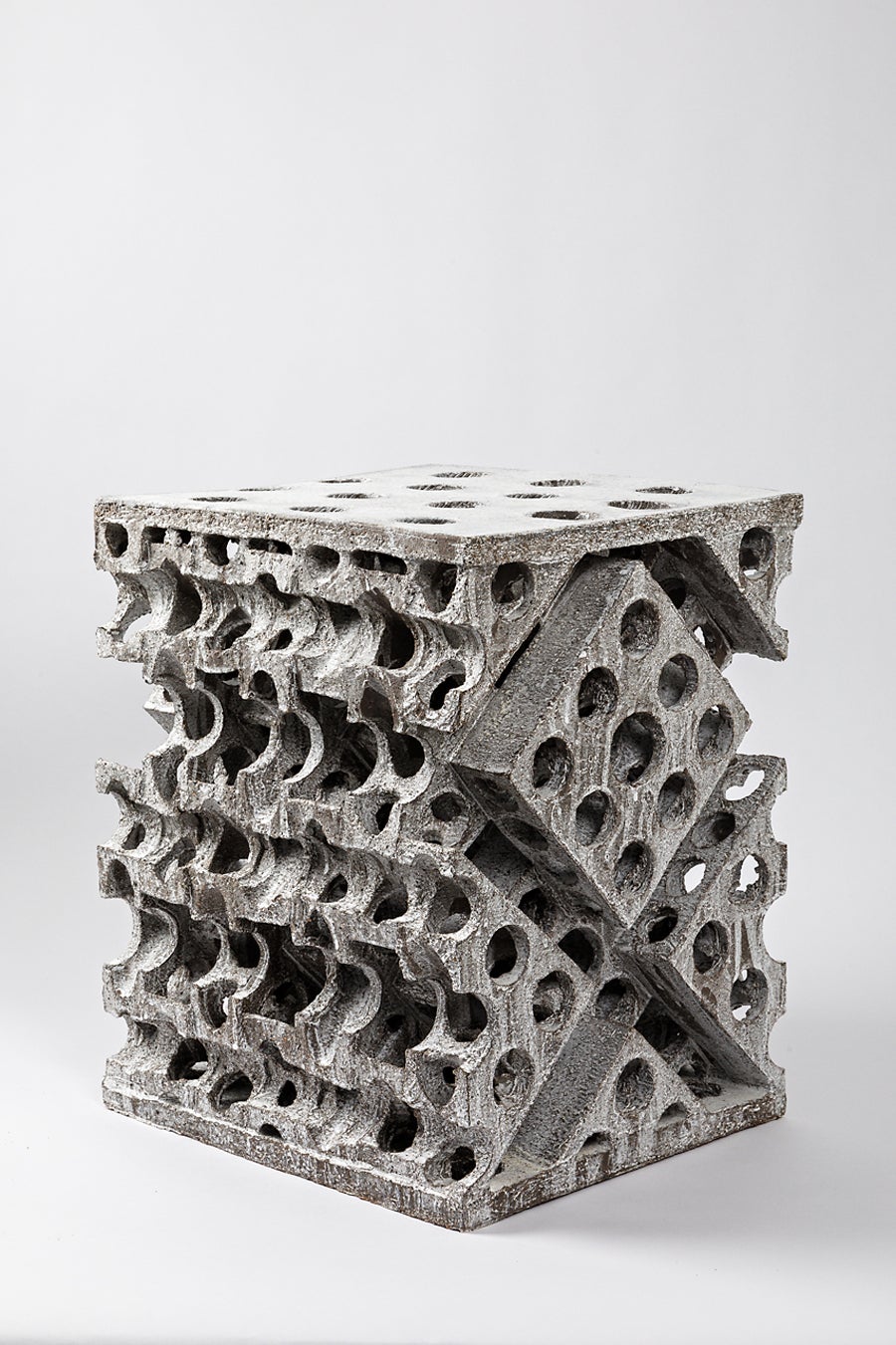
About the Seller
5.0
Vetted Professional Seller
Every seller passes strict standards for authenticity and reliability
Established in 2016
1stDibs seller since 2017
185 sales on 1stDibs
Typical response time: 4 hours
- ShippingRetrieving quote...Shipping from: Paris, France
- Return Policy
Authenticity Guarantee
In the unlikely event there’s an issue with an item’s authenticity, contact us within 1 year for a full refund. DetailsMoney-Back Guarantee
If your item is not as described, is damaged in transit, or does not arrive, contact us within 7 days for a full refund. Details24-Hour Cancellation
You have a 24-hour grace period in which to reconsider your purchase, with no questions asked.Vetted Professional Sellers
Our world-class sellers must adhere to strict standards for service and quality, maintaining the integrity of our listings.Price-Match Guarantee
If you find that a seller listed the same item for a lower price elsewhere, we’ll match it.Trusted Global Delivery
Our best-in-class carrier network provides specialized shipping options worldwide, including custom delivery.More From This Seller
View AllImportant and sober Italian Renaissance Credenza
Located in Saint-Ouen, FR
ORIGIN : ITALY, VENICE
PERIOD : 16th CENTURY
Height: 103 cm
Length: 174 cm
Depth 45 cm
Walnut
Usual restoration
The low sideboard with several doors became more common in the...
Category
Antique 16th Century Italian Renaissance Credenzas
Materials
Walnut
Important Italian Renaissance Polychrome Chest with Coat-of-Arms
Located in Saint-Ouen, FR
Important Italian Renaissance Polychrome chest with coat-of-arms
Origin: Italy
Period: early 16th century
Height: 71cm
Length: 190cm
Depth: ...
Category
Antique 16th Century Renaissance Blanket Chests
Materials
Wood
Rare and Important German Renaissance Chest
Located in Saint-Ouen, FR
Oakwood
Original lock and key
This beautiful and robust chest stands on square feet ending in flattened buns. The base presents plain mouldings. The facade is divided in four panel...
Category
Antique 16th Century German Renaissance Blanket Chests
Materials
Wood, Walnut
Important Renaissance Cabinet from Lyon 'France' with a Decor of Perspectives
Located in Saint-Ouen, FR
As soon as 1540 France's second Renaissance is in the making, intimately linked to the rediscovery of the Antique world. The development of the printing and engraving industry allows the spread of artworks and models in many cities and countries. The Italian influence can be perceived in every artistic field. While the French king entrust the most talented Italian artists with major projects such as Il Rosso or Primaticcio in Fontainebleau, French artists also travel to Italy to form themselves to this new style. In Italy they get acquainted with the work of Leo Battista Alberti the first to theorize perspective (De Pictura, 1435-36) and architecture (De re oedificatoria, 1541). Those two publications would have a revolutionary impact on arts.
Furniture is marked by the work of the most famous Italian architects of the time as well as French architects. Indeed Philibert de l'Orme competes with Alberti and by the end of his life publishes several treaties including one devoted to a theory of architecture (1567). Unfortunately he would not live to complete the second volume. In this treaty he expresses his interest for mathematical norms applied to architecture, copied from the Antique. His journeys in Italy allowed him to accumulate the most sophisticated references. Jean Bullant, another architect of great talent also theorizes his practice. He establishes rules characterizing Greco-Roman art staying faithful to Vitruvius.
Following this new inspiration the structure of furniture evolves. From then on appear columns, capitals, cornices, friezes and architraves. The ornamentation uses this inspiration as well with egg-and-dart, palm leaf and rose adorning the most beautiful pieces.
In Lyon, crossroad where meet merchants from everywhere those new experiments are welcomed. Lyon florishing printing industry allows the spreading of models and treaties essential to the artist's work. Thus the first publication of Vitruvius' De Architectura in France would be printed in Lyon in 1532.
Artists from Lyon rediscover and familiarize themselves with the Antique knowledge very early. They adopt those new ideas and use them in their own creations. Lyon cabinet-makers re interpret Antique architecture and Italian Renaissance palaces to give their pieces a pure and harmonious architectural structure. Grooved pilasters are particularly favored. They are topped by capitals of diverse orders always respecting the sequencing with simpler ones for the lower levels and the richest ones on the higher levels. As for the ornamentation, one of the great distinctiveness of Lyon workshops remains the architectural perspective illusions, drawing inspiration from Tuscany.
True masterpiece of the Second French Renaissance this important cabinet illustrates Lyon workshops' taste for fine Italian architecture inspired by Antiquity. An architectural perspective of great quality is treated in symmetry on each panel.
This two-bodied cabinet without recess stands on four rectangular feet. The base comprises a molding, a palm leaf frieze and is bordered by a braid.
The lower body is divided by three grooved pilasters with Tuscan capitals framing two door-leaves. The two panels are encircled by a moudled frame with palm leaves. They are finely carved with a decor of fantasized architecture depicting an Italian Renaissance palace erected symmetrically on each side of a grooved pilaster. On the ground floor a door opens through a stilted arch while the stories are opened with mullioned windows, dormers and occuli. Two large pegged-boss cladded pillars support the entablature enriched by a palm leaf frieze upon which stands an arch whose coffered intrados is centred by a rose. Behind this arch a pyramid appears, standing in front of a second facade with a window topped by a broken curvilinear pediment under a cul-de-four with a shell.
The checker flooring gives depth to the low-reliefs creating vanishing points structuring the panels and guiding the eye of the observer.
A thin laurel braid highlights the belt of the cabinet where are located two drawers. Their facades are adorned by palm leaves in hoops.
The upper body is encircled with palm leaves. The same ternary division as in the lower body appears. However, the pilasters are topped by Ionic capitals with volutes and egg-and-dart. The door-leaves are framed with flowers. On the panels the artist has designed another architectural decor. On the foreground open two arches on top of grooved pilasters with rectangular capitals adorned with palm leaves. The arches are enriched with braids and the coffered intrados bears a decor of roses. The spandrels also bear a flower decor. In the background another arcature hosts a fluted grooved column topped with double basket acanthus capital, characteristic of Corinthian order. The triangular pediment is interrupted by a choux bourguignon.
A large cornice crowns the cabinet. It stands on pilasters and forms an entablature comprising a palm leaf frieze and an egg-and-dart, triglyph and palm leaf cornice.
The cabinet's sides have also been carefully considered. The lower body's panels are enriched with an arch rising above a broken pediment portico hosting a twisted column. Flowers garnish the spandrels. An architectural facade completes the decor. The upper body's panels present two arches supported by a facade opened with dormers and mullioned windows as well as cartouches (one bears the inscription 1580 dating the cabinet) suggesting the interior of an Italian Renaissance palace, confirmed by the chandeliers. The flooring leads our gaze to a second arch with a broken curvilinear pediment where stands a flower vase. This arch opens onto a perspective of another facade along a road.
Inside the cabinet, on the lower body door-leaves appear two designs. On the right door is depicted a Crucifixion. Saint Mary and Saint John flank the Christ on the cross. In the bottom part is inscribed « Dure uiator abis nihil haec spectacula curas / Pendenti cum sis unica cura Deo. / Tota suo moriente dolet natura Magistro. / Nil qui solus eras caussa dolenda doles. ». The signature [Christoff Swartz Monachiensis pinx[it] / Ioa[nnes] Sadeler sculp[it]] tells us it was made by Johan Sadeler I (1550-1600) after Christoph Schwartz (1548-1592). This engraving belongs to an ensemble depicting the Passion of Christ Johan Sadeler executed in 1589 after an altar piece painted by Christoph Schwartz for the private chapel of Renée of Loraine, wife of Duke William V of Bavaria. This altar piece made of nine copper panels has been destroyed during the 19th century. The Crucifixion panel once in the centre of the altar piece is the only one that survived and is today kept in Munich's Alte Pinakothek.
On the left door appears Saint Francis receiving the stigmata. The inscription says : « Signastidomine Servum Tuum. Franciscum. Signis Redemptionis Nostrae ».
This Renaissance cabinet with an architectural decor appearing as much in the structure faithful to Antique rules...
Category
Antique 16th Century European Renaissance Cabinets
Materials
Walnut
Italian Renaissance Wedding Cassone
Located in Saint-Ouen, FR
Italian Renaissance wedding cassone
Origin : Northern Italy, Between Milan And Bologne
Period : 15th Century
Height : 55 cm
Width : 156.5 cm
D...
Category
Antique 15th Century and Earlier Renaissance Blanket Chests
Materials
Walnut
Exceptional Italian Renaissance "Cassone"
Located in Saint-Ouen, FR
Exceptional Italian Renaissance « Cassone »
Origine : Italy, Florence or Siena
Period : Late 15th Century
Measures: Height: 63 cm
Length: 1...
Category
Antique 15th Century and Earlier Blanket Chests
Materials
Walnut
You May Also Like
Garden Planter
Located in London, England
Concrete garden planter.
France Circa 1930.
H 60cm x W 56cm x D 56cm
IMPORTANT
Please be in contact before making a purchase, with your delivery address so we can give an accurate...
Category
Vintage 1930s Garden Ornaments
Materials
Concrete
$726
Floral Shaped Garden Planter
Located in South Salem, NY
An open lily shaped cast iron and plaster covered garden urn. The plaster has been stained in a coral color. Square base. Wear consistent with age.
Category
Early 20th Century British Garden Ornaments
Materials
Iron
Pair of Egyptian Revival Italian Specimen Marble Obelisks
Located in London, GB
Pair of Egyptian Revival Italian specimen marble obelisks
Italian, 20th Century
Measures: Height 262cm, width 54cm, depth 54cm
The obelisk...
Category
20th Century Italian Egyptian Revival Pedestals and Columns
Materials
Siena Marble, Porphyry, Marble
Pair of Lead Garden Planters
By Robert Adam
Located in Faversham, GB
A fabulous pair of lead urns based on the design of the British Georgian architect Robert Adam.
Neoclassical in design with fluted decoration to the sides and base.
The urns are he...
Category
Early 20th Century British Neoclassical Garden Ornaments
Materials
Lead
$1,315 Sale Price
20% Off
Acanthus Leaf Weathered Garden Planter
Located in Godshill, Isle of Wight
Acanthus leaf weathered garden planter
A good early 20th century planter, it is well weathered and has drainage in the centre, the urn separates in...
Category
Early 20th Century Belle Époque Garden Ornaments
Materials
Cement
Pair of 1990s Spanish Aged Macael White Marble Urn Garden Planters w/ Inlay
Located in Marbella, ES
Pair of 1990s Spanish hand carved aged Macael white marble fluted urn garden planters with Serpentine green marble inlays.
Category
Late 20th Century Spanish Planters and Jardinieres
Materials
Marble
Recently Viewed
View AllMore Ways To Browse
Used Garden Planters
Antique Garden Planters
Marble Face
Italian Renaissance Frame
Renaissance Marble
Marble Heart
Marble Mask
Marble Tree
Italian Renaissance Revival
Italian Renaissance Marble
Italian Renaissance Architecture
Antique Italian Revival Furniture
Winged Lion
Marble Bear
Marble Eagle
Antique Marble Head
Marble Grapes
Garden Furniture Grape
